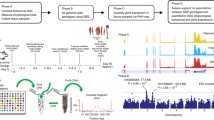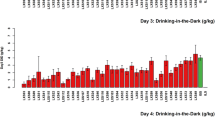Abstract
Excessive alcohol (ethanol) consumption is the hallmark of alcohol use disorders. The F1 hybrid cross between the C57BL/6J (B6) and FVB/NJ (FVB) inbred mouse strains consumes more ethanol than either progenitor strain. The purpose of this study was to utilize ethanol-drinking data and genetic information to map genes that result in overdominant (or heterotic) ethanol drinking. About 600 B6 × FVB F2 mice, half of each sex, were tested for ethanol intake and preference in a 24-h, two-bottle water versus ethanol choice procedure, with ascending ethanol concentrations. They were then tested for ethanol intake in a Drinking in the Dark (DID) procedure, first when there was no water choice and then when ethanol was offered versus water. DNA samples were obtained and genome-wide QTL analyses were performed to search for single QTLs (both additive and dominance effects) and interactions between pairs of QTLs, or epistasis. On average, F2 mice consumed excessive amounts of ethanol in the 24-h choice procedure, consistent with high levels of consumption seen in the F1 cross. Consumption in the DID procedure was similar or higher than amounts reported previously for the B6 progenitor. QTLs resulting in heightened consumption in heterozygous compared to homozygous animals were found on Chrs 11, 15, and 16 for 24-h choice 30% ethanol consumption, and on Chr 11 for DID. No evidence was found for epistasis between any pair of significant or suggestive QTLs. This indicates that the hybrid overdominance is due to intralocus interactions at the level of individual QTL.









Similar content being viewed by others
References
Belknap JK, Atkins AL (2001) The replicability of QTLs for murine alcohol preference drinking behavior across eight independent studies. Mamm Genome 12:893–899
Belknap JK, Crabbe JC, Young ER (1993) Voluntary consumption of ethanol in 15 inbred mouse strains. Psychopharmacology 112:503–510
Bergeson SE, Kyle Warren R, Crabbe JC, Metten P, Erwin VG et al (2003) Chromosomal loci influencing chronic alcohol withdrawal severity. Mamm Genome 14:454–463
Blednov YA, Metten P, Finn DA, Rhodes JS, Bergeson SE et al (2005) Hybrid C57BL/6J × FVB/NJ mice drink more alcohol that do C57BL/6J mice. Alcohol Clin Exp Res 29:1949–1958
Boehm SL II, Schafer GL, Phillips TJ, Browman KE, Crabbe JC (2000) Sensitivity to ethanol-induced motor incoordination in 5-HT(1B) receptor null mutant mice is task-dependent: implications for behavioral assessment of genetically altered mice. Behav Neurosci 114:401–409
Bohman M, Cloninger R, Sigvardsson S, von Knorring AL (1987) The genetics of alcoholisms and related disorders. J Psychiatr Res 21:447–452
Broman KW, Wu H, Sen S, Churchill GA (2003) R/qtl: QTL mapping in experimental crosses. Bioinformatics 19:889–890
Broman KW, Sen S, Owens SE, Manichaikul A, Southard-Smith EM et al (2006) The X chromosome in quantitative trait locus mapping. Genetics 174:2151–2158
Bruell JH (1967) Behavioral heterosis. In: Hirsch J (ed) Behavior-genetic analysis. McGraw-Hill, New York, pp 270–286
Chesler EJ, Lu L, Shou S, Qu Y, Gu J et al (2005) Complex trait analysis of gene expression uncovers polygenic and pleiotropic networks that modulate nervous system function. Nat Genet 37:233–242
Crabbe JC, Metten P, Rhodes JS, Yu CH, Brown LL et al (2009) A line of mice selected for high blood ethanol concentrations shows drinking in the dark to intoxication. Biol Psychiatry 65:662–670
Crews FT, Boettiger CA (2009) Impulsivity, frontal lobes and risk for addiction. Pharmacol Biochem Behav 93:237–247
Ducci F, Goldman D (2008) Genetic approaches to addiction: genes and alcohol. Addiction 103:1414–1428
Falconer DS, Mackay TFC (1996) Introduction to quantitative genetics, 4th edn. Longman Group Ltd, Essex, UK
Gabriel KI, Cunningham CL (2008) Effects of maternal strain on ethanol responses in reciprocal F1 C57BL/6J and DBA/2J hybrid mice. Genes Brain Behav 7:276–287
Gill K, Boyle AE (2005) Genetic analysis of alcohol intake in recombinant inbred and congenic strains derived from A/J and C57BL/6J progenitors. Mamm Genome 16:319–331
Godoy-Herrera R (1994) Biometrical analysis of larval digging in Drosophila melanogaster. Behav Genet 24:427–432
Goodrick CL (1978) Ethanol selection by inbred mice. Mode of inheritance and the effect of age on the genetic system. J Stud Alcohol 39:19–38
Hood HM, Belknap JK, Crabbe JC, Buck KJ (2001) Genomewide search for epistasis in a complex trait: pentobarbital withdrawal convulsions in mice. Behav Genet 31:93–100
Kearsey MJ, Pooni HS (1996) The genetical analysis of quantitative traits. Chapman & Hall, London
Keppel G, Wickens TD (2004) Design and analysis: a researcher’s handbook, 4th edn. Pearson Prentice-Hall, Upper Saddle River, NJ
Kuo PH, Kalsi G, Prescott CA, Hodgkinson CA, Goldman D et al (2008) Association of ADH and ALDH genes with alcohol dependence in the Irish affected sib pair study of alcohol dependence (IASPSAD) sample. Alcohol Clin Exp Res 32:785–795
Moore EM, Boehm SL II (2009) Site-specific microinjection of baclofen into the anterior ventral tegmental area reduces binge-like ethanol intake in male C57BL/6J mice. Behav Neurosci 123:555–563
Mulligan MK, Ponomarev I, Hitzemann RJ, Belknap JK, Tabakoff B et al (2006) Toward understanding the genetics of alcohol drinking through transcriptome meta-analysis. Proc Natl Acad Sci USA 103:6368–6373
Palmer AA, Low MJ, Grandy DK, Phillips TJ (2003) Effects of a Drd2 deletion mutation on ethanol-induced locomotor stimulation and sensitization suggest a role for epistasis. Behav Genet 33:311–324
Rhodes JS, Best K, Belknap JK, Finn DA, Crabbe JC (2005) Evaluation of a simple model of ethanol drinking to intoxication in C57BL/6J mice. Physiol Behav 84:53–63
Rhodes JS, Ford MM, Yu CH, Brown LL, Finn DA et al (2007) Mouse inbred strain differences in ethanol drinking to intoxication. Genes Brain Behav 6:1–18
Rosenthal R (1994) Parametric measures of effect size. In: Cooper H, Hedges LV (eds) The handbook of research synthesis. Russell Sage Fnd, New York, pp 232–244
Schuckit MA (2009) An overview of genetic influences in alcoholism. J Subst Abuse Treat 36:S5–S15
Short JL, Drago J, Lawrence AJ (2006) Comparison of ethanol preference and neurochemical measures of mesolimbic dopamine and adenosine systems across different strains of mice. Alcohol Clin Exp Res 30:606–620
Song MJ, Lewis CK, Lance ER, Chesler EJ, Yordanova RK et al (2009) Reconstructing generalized logical networks of transcriptional regulation in mouse brain from temporal gene expression data. EURASIP J Bioinform Syst Biol, article ID 545176:1–13
Tabakoff B, Saba L, Kechris K, Hu W, Finn DA et al (2008) The genomic determinants of alcohol preference in mice. Mann Genome 19:352–365
Thompson RG Jr, Lizardi D, Keyes KM, Hasin DS (2008) Childhood or adolescent parental divorce/separation, parental history of alcohol problems, and offspring lifetime alcohol dependence. Drug Alcohol Depend 98:264–269
Vadasz C, Saito M, Gyetvai BM, Oros M, Szakall I et al (2007) Mapping of QTLs for oral alcohol self-administration in B6.C and B6.I quasi-congenic RQI strains. Neurochem Res 32:1099–1112
Wahlsten D, Bachmanov A, Finn DA, Crabbe JC (2006) Stability of inbred mouse strain differences in behavior and brain size between laboratories and across decades. Proc Natl Acad Sci USA 103:16364–16369
Yoneyama N, Crabbe JC, Ford MM, Murillo A, Finn DA (2008) Voluntary ethanol consumption in 22 inbred mouse strains. Alcohol 42:149–160
Acknowledgments
This work was supported by the Department of Veterans Affairs and by NIAAA grants U01 AA016655, U01 AA013484, and P60 AA010760.
Author information
Authors and Affiliations
Corresponding author
Rights and permissions
About this article
Cite this article
Phillips, T.J., Reed, C., Burkhart-Kasch, S. et al. A method for mapping intralocus interactions influencing excessive alcohol drinking. Mamm Genome 21, 39–51 (2010). https://doi.org/10.1007/s00335-009-9239-9
Received:
Accepted:
Published:
Issue Date:
DOI: https://doi.org/10.1007/s00335-009-9239-9




